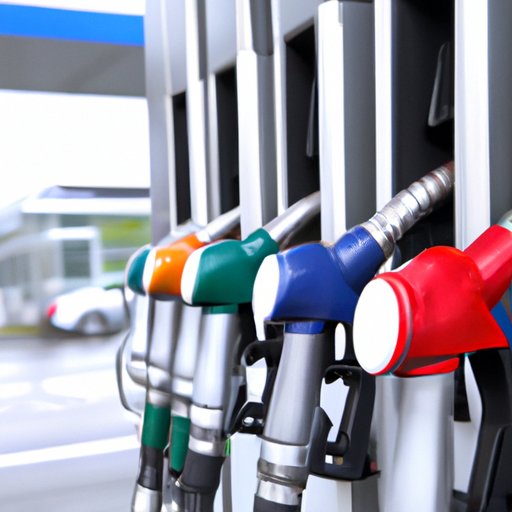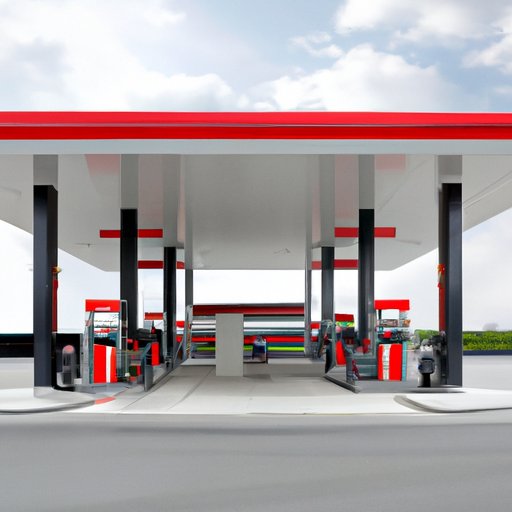
Introduction
Gas stations are ubiquitous on our roads and highways, providing us with the fuel we need to keep our vehicles running. But have you ever wondered how gas stations make money on the fuel they sell? Understanding the economics behind gas sales is important both for consumers and for gas station owners. In this article, we’ll take a deep dive into the world of gas station economics and explore exactly how gas stations make money on fuel sales.
Breaking Down the Economics of Gas Stations: How They Make Money on Fuel Sales
At its most basic level, gas stations make money on the difference between the price they pay to purchase gasoline and the price at which they sell it to consumers. However, there are many costs associated with producing and transporting gasoline that must be factored in to determine a gas station’s profit margin. These costs include crude oil prices, refining costs, taxes, transportation, overhead, and various other expenses.
The gross profit margin is the difference between the cost to purchase gasoline and the price at which it is sold. According to the National Association of Convenience Stores (NACS), the average gross profit margin on a gallon of gasoline in 2020 was about 22 cents. However, the net profit margin, which takes into account all of the expenses associated with producing and selling gasoline, is much lower, typically around two to three cents per gallon.
The Surprising Truth About Gas Station Profit Margins and How They Affect Prices
While gas sales are undoubtedly a major source of revenue for gas stations, they are not the only way that these businesses make money. Convenience store sales, for example, often have much higher profit margins than gasoline sales. In fact, according to NACS, convenience store sales account for the majority of profits for many gas stations.
Gas stations also have to factor in the changing price of gasoline when setting their prices. The profit margins are so thin that when oil prices rise, gas stations may have to raise their prices just to keep the same profit margin.
Exploring the Business Model of Gas Stations: From Gasoline Sales to Convenience Store Profits
Gone are the days when gas stations only sold fuel and oil. Today, it’s not uncommon to see gas stations with a mini-mart, a car wash, or even fast food restaurants. These businesses don’t just rely on fuel sales to keep their doors open; they also sell snacks, beverages, and other convenience items. Convenience store sales are often much more profitable for gas stations than gas sales.
Gas stations also use their convenience stores to increase revenue in other ways. For example, they may partner with food brands to offer limited-time promotions or sell their own branded merchandise and snacks to encourage repeat business.
The Science of Gas Station Pricing: Why Gas Prices Fluctuate and How Stations Stay Profitable
There are many factors that can affect the price of gasoline, including supply and demand, seasonal fluctuations, government regulations, and competition between gas stations. Many of these factors are outside of the control of gas stations, which can make it challenging to set prices that are both competitive and profitable.
Gas stations use a variety of pricing strategies to stay profitable, including dynamic pricing, price matching with competitors, and loyalty programs that offer discounts to frequent customers. By constantly monitoring market conditions and experimenting with different pricing strategies, gas stations can gain a competitive advantage and attract more customers.

The Future of Gas Stations: Technological Advances and Changing Consumer Habits that Affect Profitability
The world of transportation is rapidly changing, and gas stations are not immune to these changes. Technology is playing an increasingly important role in both the production of gasoline and the distribution of fuel. For example, some gas stations now use artificial intelligence to predict demand and set prices accordingly, while others are experimenting with biofuels and other alternative fuels.
Consumer habits are also changing, as more and more people are purchasing electric and hybrid vehicles. This shift away from traditional gasoline-powered cars could potentially have a major impact on gas station profitability and could mean that gas stations need to explore new business models in order to stay relevant.
Innovative Strategies for Gas Stations to Increase Revenue: From Loyalty Programs to Alternative Fuel Options
To stay competitive in a rapidly evolving market, gas stations are coming up with new and innovative ways to attract customers and increase revenue. One popular strategy is to offer loyalty programs that reward repeat customers with discounts on fuel, food, and other convenience items.
Another innovative strategy is to offer alternative fuels, such as biofuels, ethanol, and electric charging stations, which can appeal to eco-conscious consumers and those with electric or hybrid vehicles.
Conclusion
In conclusion, while gas sales are undoubtedly an important revenue stream for gas stations, they are not the only way these businesses make money. Convenience store sales, alternative fuel options, and innovative pricing strategies are just a few of the ways that gas stations can stay competitive and increase revenue in a changing market. By understanding the economics behind gas sales and staying adaptable to changing consumer habits and technological advancements, gas station owners can ensure their businesses remain profitable for years to come.





